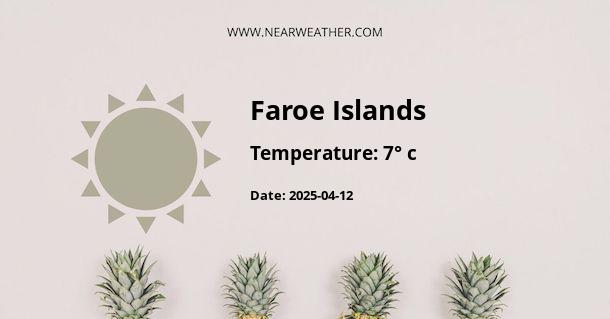Climate and Weather in the Faroe Islands
The Faroe Islands, located in the North Atlantic Ocean, between Iceland and Norway, have a unique and diverse climate. The weather in the Faroe Islands is heavily influenced by the North Atlantic Drift, a warm ocean current that brings mild temperatures to the region. However, the islands are also subject to frequent changes in weather, with strong winds, fog, and rain being common occurrences.
Temperature
The Faroe Islands have a cool and temperate climate, with relatively mild winters and cool summers. The average temperature in the summer months, from June to August, is around 10-12°C (50-54°F), while in winter, from December to February, temperatures average around 3-5°C (37-41°F). The islands rarely experience extreme temperatures, with the highest recorded temperature being 24.5°C (76.1°F) and the lowest being -11.2°C (11.8°F).
Due to the maritime influence, the temperature in the Faroe Islands remains fairly stable throughout the year. The warm North Atlantic Drift helps to moderate the temperatures, preventing them from dropping too low in winter and keeping them from rising too high in summer.
Precipitation
The Faroe Islands are known for their high levels of precipitation, with rain being a common occurrence throughout the year. The islands experience an average of 250-300 rainy days per year, with the highest rainfall occurring between September and January. The annual precipitation in the Faroe Islands ranges from 1,200 to 2,000 millimeters (47 to 79 inches), with the southern parts of the islands receiving slightly less rainfall than the northern parts.
The combination of the islands' location in the North Atlantic and the presence of mountains contributes to the high levels of precipitation. The mountains act as barriers, causing the moist air from the ocean to rise and condense, resulting in frequent rainfall.
Sunshine Hours
The Faroe Islands experience relatively low levels of sunshine compared to many other locations. The islands receive an average of 800-1,000 sunshine hours per year, with the lowest number of sunshine hours occurring in winter. The long summer days, however, provide an opportunity for more daylight and sunshine, with the longest day of the year, known as the summer solstice, having nearly 19 hours of daylight.
Wind
Strong winds are a common feature of the Faroe Islands' climate. The islands are exposed to the prevailing westerly winds, which can reach speeds of up to 25-30 knots (29-35 mph). The combination of the open ocean and mountainous terrain makes the Faroe Islands particularly prone to strong winds, especially during the winter months.
Fog
Fog is another characteristic weather phenomenon in the Faroe Islands. The combination of the cool ocean currents and the warm air from the North Atlantic Drift can result in the formation of dense fog, reducing visibility. Fog can occur throughout the year, but it is more common in the summer months, particularly in the mornings and evenings.
Climate Summary
The climate of the Faroe Islands can be summarized as cool, temperate, and oceanic. The islands experience mild temperatures, high levels of precipitation, frequent rain, strong winds, and occasional fog. The North Atlantic Drift plays a significant role in moderating the climate, ensuring relatively stable temperatures throughout the year.
It is important for visitors to the Faroe Islands to be prepared for the changing weather conditions and to dress appropriately. Layered clothing, waterproof outerwear, and sturdy footwear are recommended to ensure comfort and protection against the elements.
A - Faroe Islands's Latitude is 62.000000 & Longitude is -7.000000.
A - Weather in Faroe Islands is 7° today.
A - Climate Conditions in Faroe Islands shows light rain today.
A - Humidity in Faroe Islands is 70% today.
A - Wind speed in Faroe Islands is 5.54 km/h, flowing at 80° wind direction. today.
